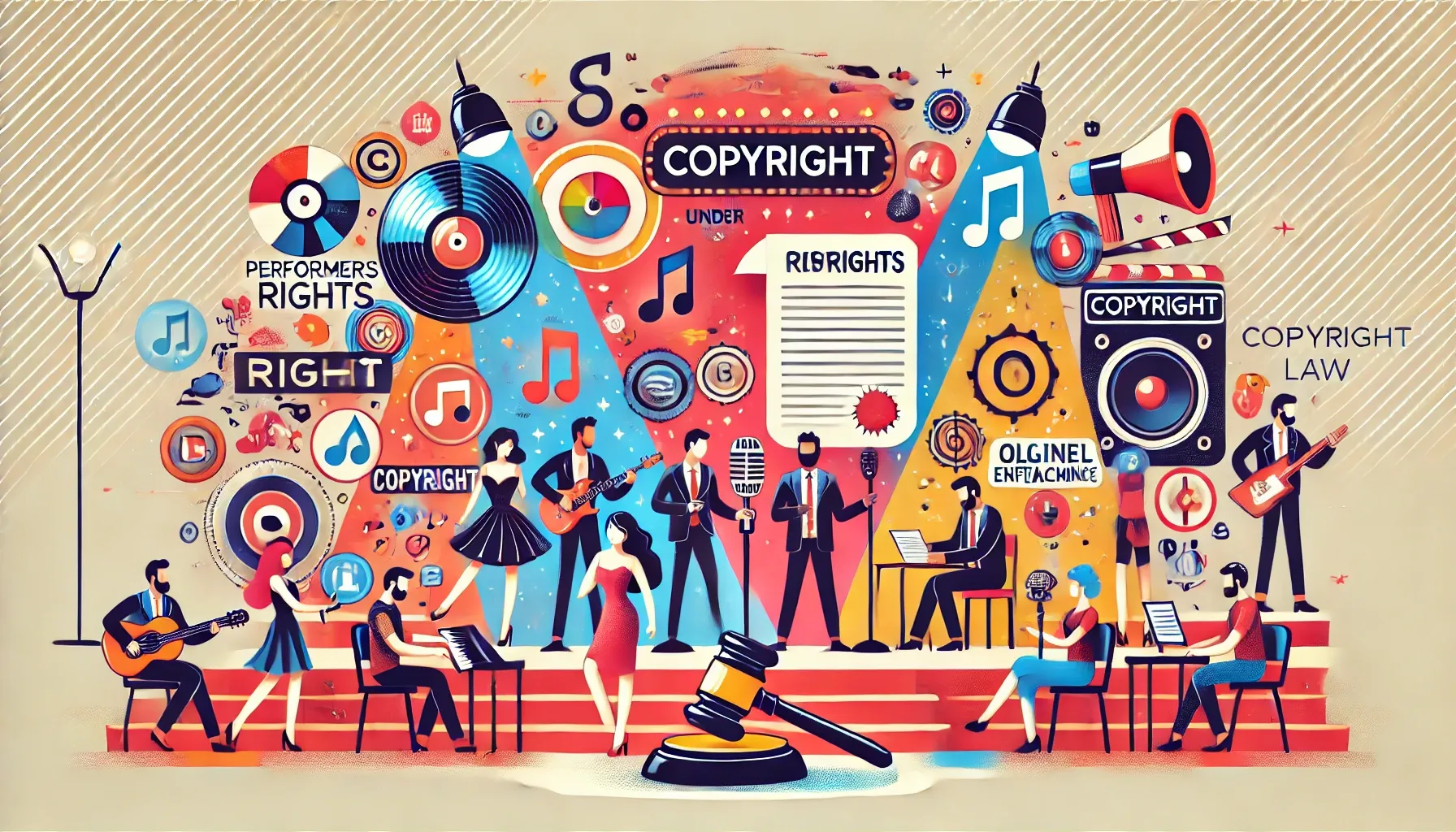Performers' rights under copyright law recognize the contributions of artists like actors, musicians, and dancers. These rights offer protections against unauthorized use, ensure fair compensation, and uphold moral rights, enhancing their creative and economic interests.

Introduction
The evolution of performers’ rights within copyright law has been a gradual and transformative process. Initially, performers were not recognized as having specific rights under copyright law. Their contributions, such as acting, singing, dancing, or playing music, were often considered part of unproductive labor and their performances were not seen as protectable works. However, with the development of new technologies, including sound recording and broadcasting, the need to safeguard performers' contributions became apparent. Over time, international treaties and national legal frameworks, including amendments to India’s Copyright Act, progressively acknowledged the rights of performers, allowing them to secure compensation and moral rights for their works.
Origin and Development of Performers' Rights
Historically, the rights of performers were neglected in early copyright law. The first recognition of such rights came through the Rome Convention of 1961, which was the first international legal instrument to specifically address and protect performers’ rights. This Convention, spearheaded by the International Labor Organization (ILO), the United Nations Educational, Scientific and Cultural Organization (UNESCO), and the World Intellectual Property Organization (WIPO), sought to provide performers with exclusive rights over their live performances and protect them from unauthorized exploitation. This was a significant milestone, as performers were previously seen as unimportant contributors in the creative process, despite their essential role in bringing artistic works to life. The Rome Convention recognized performers' rights for a period of 20 years from the conclusion of the year in which the performance occurred, offering protections against unauthorized recording, broadcasting, or reproduction.
In India, the concept of performers’ rights was almost non-existent when the Copyright Act of 1957 was first enacted. It was not until the Fortune Films v. Dev Anand[1] case in 1979 that the issue of performers' rights was brought into the judicial spotlight. The Bombay High Court ruled that performers had no rights to control how their performances were used, as they were not explicitly recognized in the Copyright Act. This decision highlighted the gap in Indian copyright law and led to calls for reform.
Legislative Developments in India
- The landmark Copyright Amendment Act of 1994 was a turning point in India’s recognition of performers’ rights. The amendment introduced Section 38[2] to the Copyright Act, which explicitly acknowledged the rights of performers.
- Additionally, Section 2(qq)[3] defined the term “performer” to include actors, dancers, musicians, singers, acrobats, conjurers, snake charmers, jugglers, and lecturers, among others. The 1994 amendment marked the first formal legal acknowledgment of performers as holders of certain exclusive rights.
- Further expansion of these rights occurred with the 2012 amendment, which incorporated Sections 38-A and 38-B[4], providing for both the economic or exclusive and moral rights of performers.
- Economic rights included the right to authorize the recording, reproduction, and distribution of performances, while moral rights encompassed the right to be identified as the performer and the right to prevent distortion or modification of their performance.
- The amendments also introduced provisions for remedies against infringement, such as civil and criminal actions, and the Anton Pillar Order, which allows performers to inspect and seize evidence in cases of copyright infringement.
International Influence on Indian Law
India’s development of performers' rights was heavily influenced by international treaties, particularly the Rome Convention and the Agreement on Trade-Related Aspects of Intellectual Property Rights (TRIPS). The Rome Convention, adopted in 1961, set a precedent for the protection of performers worldwide. Under this Convention, performers were granted exclusive rights over the broadcasting or communication of their performances, ensuring they were entitled to compensation for the commercial use of their work. TRIPS further strengthened these protections by mandating that members of the World Trade Organization (WTO), including India, adhere to specific provisions related to the protection of performers' rights.
India’s Copyright Act was adapted to comply with these international standards, expanding the scope of performers' rights beyond what was initially outlined in domestic law. The Indian version of performers’ rights not only aligns with the Rome Convention and TRIPS, but also goes beyond their requirements, offering broader protection to a wider range of performers, including those not traditionally seen as creative artists, such as acrobats and lecturers.
Performer's Rights Under Copyright Law in India
Under the Indian Copyright Act, 1957, performers are granted specific rights that protect their creative works and contributions. These rights ensure that performers retain control over how their performances are used, broadcast, and reproduced. The following rights are:
- Right to Record Sound or Vision: A performer has the right to record their performance in either sound or visual format. They also have the authority to grant permission for others to record their live performances. No one else can use the recorded performance without obtaining the performer’s consent. However, when the performance is part of a cinematographic film, and the performer has signed a written agreement, the rights to the performance transfer to the producer of the film. This applies whether the performer is an actor, singer, or instrumentalist.
- Right to Produce the Sound or Visual Recording: A performer may also act as the producer of their own sound or visual recording. As a producer, they are entitled to all the rights associated with production, such as reproducing copies of the recording, renting those copies for commercial purposes, and making the work available to the public. However, to exercise these rights, the performer must seek permission from other copyright holders, such as lyricists or composers, and must comply with necessary legal formalities.
- Right to Broadcast Live Performances: Performers have the right to control the broadcasting of their live performances. Without the performer’s consent, broadcasting or transmission of their performance would be considered an infringement of their copyright. If the performance is for a cinematograph film, the producer holds the rights, but the performer can still demand royalties if the performance is exploited commercially outside the film’s context.
- Right to Communicate the Work to the Public: Performers can communicate their work through various means beyond traditional broadcasting. This may include new-age methods such as streaming on social media platforms, cable TV, or OTT (Over-The-Top) services. This broadens the reach of the performer’s rights, allowing them to control how their performance is shared with the public.
Moral Rights of the Performer
- Moral rights of performers are vital protections that ensure their recognition and the integrity of their work, even after they have transferred the rights to a third party.
- These rights include the right to be identified as the creator of the performance and the right to object to any changes that could harm their reputation or artistic vision. The right to recognition allows performers to ensure their identity is credited, regardless of who holds the rights to the work. Additionally, performers are entitled to prevent any distortion or alteration of their performance that could be detrimental to their honour or reputation.
- However, the moral right of a performer is not infringed if alterations to the work are made for practical reasons, such as technical limitations or time constraints in the context of a cinematographic film. For example, if a producer shortens a performance due to time limits, this does not violate the performer's moral rights.
- Furthermore, moral rights are separate from copyright ownership. The Delhi High Court’s ruling in Super Cassettes Industries v. Bathla Cassette Industries[5] emphasized that performers' rights cannot be conflated with the rights of the copyright owner.
- Even when a performer assigns their rights to a producer, their moral right to be recognized for their work remains.
- This distinction ensures that performers maintain a unique connection to their performances, irrespective of the ownership of the copyright, and preserves their ability to object to modifications that could negatively impact their personal or professional reputation.
Acts Constituting Infringement of Performer’s Rights
Several actions violate the performer’s rights under the Copyright Act, including:
- Reproduction Without Permission: Reproducing a performer’s work without obtaining their consent is considered an infringement of their rights.
- Unauthorized Use of Performer's Work: Using the performer’s work for purposes other than those they have authorized constitutes infringement.
- Broadcast Without Consent: Broadcasting a performer’s work without their permission, especially in cases where the work has not been included in a cinematograph film, is a violation.
- Unauthorized Communication: Communicating a performer’s work to the public without their consent, outside of agreed-upon terms or exceptions, also infringes on their rights.
Acts Not Constituting Infringement
However, not all acts involving the performer’s work are considered infringements. The following activities are typically excluded from being deemed infringements under the Copyright Act:
- Recreating a sound or video recording for personal use or for educational purposes is not an infringement.
- Reproduction for the purpose of legal proceedings is not an infringement.
- Reproduction of the work for purposes such as criticism, review, or news reporting may not be considered infringing, provided it is done in accordance with the doctrine of fair dealing.
- When the work is reproduced for use by the legislature, it is exempt from infringement.
- Other uses not considered infringing under Section 52 of the Copyright Act[6].
Remedies for Infringement of Performer’s Rights
Section 55 of the Copyright Act[7], as well as Sections 63 to 70 of the Act[8], provide remedies for infringers of performer’s rights. When a performer’s rights are infringed, they have several legal remedies available:
- Civil Remedies: Performers or their exclusive licensees can approach the court for temporary or permanent injunctions, or claim damages from the infringer. The court may also order the removal or destruction of infringing copies.
- Criminal Remedies: The Copyright Act provides for criminal penalties for infringements, including imprisonment for six months to three years and fines ranging from Rs. 50,000 to Rs. 2,00,000, or both.
- Anton Piller Order: In certain cases, the court may allow a plaintiff to enter the defendant’s premises and seize relevant documents or materials without prior notice to the defendant, thus preventing the removal of evidence before a case can proceed.
- Damages: The performer can seek compensation for actual losses or statutory damages in the case of infringement.
Conclusion
The introduction of performers' rights under the Copyright Act represents significant progress in protecting the contributions of artists. These rights ensure fair recognition and compensation for performers, enhancing both their economic and moral protections. However, challenges remain, such as the dilution of transparency in copyright societies and the need for better regulation of online performances and royalty distribution. To fully realize the potential of these protections, further legislative and judicial attention is needed, especially in addressing digital-era concerns and improving the implementation of performers' rights.
[1] AIR 1979 Bom 17.
[2] The Copyright Act, 1957, s. 38.
[3] Id. at s. 2(qq).
[4] Id. at ss. 38A, 38B.
[5] 2003 (27) PTC 280 (Del).
[6] The Copyright Act, 1957, s. 52.
[7] The Copyright Act, 1997, s. 55.
[8] Id. at ss. 63-70.


